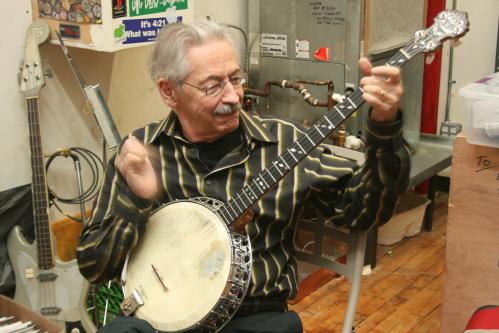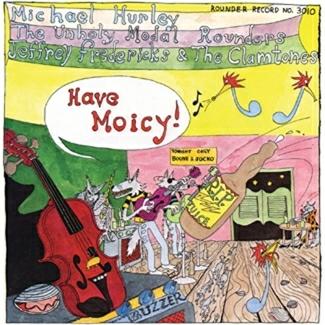|


Part 2: New York City, the Lower East Side, and Have
Moicy!
Q: Let’s jump to 1959, when you moved to New York.
I read another interview where you said that when you moved
here, everyone advised you to stay away from the Lower East
Side because it was so dirty and dangerous and scary. And
you discovered that it really wasn’t…
Peter: Well, not really. I came to New York with some friends
from Chicago in May of ’59. And that’s when
I found that the Lower East Side was cool, and the West
Village wasn’t really cool anymore. I had met a New
York girl in San Francisco and followed her here, and by
the time I got to New York, she had a new boyfriend. But
she hooked me up with one of her old boyfriends as a roommate
in an apartment on Clinton Street for $44 a month. And I
was concerned about living in a New York slum. I know the
neighborhood was cool. It wasn’t really called the
East Village yet, realtors didn’t come up with that
until ’64 or so. It was just a slum, and I was leery,
so I asked a bunch of people if it was safe to live there.
And a couple of people told me, well, a couple of years
ago, this guy got stabbed in the arm with a knife, but it
was his fault. He was drunk and started a fight. And that
was it, that was the troubles! It was actually incredibly
safe.
Q: By the time I started coming to the Lower East Side
in the late Seventies though, the neighborhood had changed
quite a bit, I assume.
Peter: In 1962, 42nd Street sleaze types started hanging
around the Bohemian scene for the first time, and the first
12-year old runaways hit the scene for the first time and
started panhandling, and you started to hear “spare
change, spare change” every time you walked down the
street. Before that, in that neighborhood, people would
say, “what do you do?,” with the assumption
that you did something artistic if you lived in that neighborhood.
If you didn’t “do” something, you were
a phony. Hippies, or hippy-dippy, originally meant wannabe.
They were people who wanted to be artistic but didn’t
really make any art. Faux proto-hipsters. But the early
Sixties was also when drug use really became a problem.
More and more straight people started using drugs, and in
the summer of ’62 there suddenly wasn’t enough
pot around to satisfy the double, triple, quadruple number
of people who were interested. Heroin was always around.
When I got here, people would say, you shouldn’t sell
pot, you should share. Selling pot isn’t righteous.
There’s a documentary of that era that’s got
Dennis Hopper, the guy in “Easy Rider,” saying,
you shouldn’t sell pot, pot is a love thing, you should
just share it. By 1968, it was a fucking nightmare. You
couldn’t find pot anywhere. People talk about the
hippie era and they say, oh, 1968 and 1969, New York was
so cool in those days. It was nightmare central by that
time. The whole thing went off the wheels by 1968, big-time.
There was just massive numbers of people coming to the Lower
East Side like they were joining the set on a movie shoot.
The whole scene looks so idyllic from the outside world,
the flower children with their peace and love. And actually
what happened is that it attracted every sleazeball criminal
ex-con scumbag in the country. Wow, teenage girls who fuck
for drugs, let’s get in on that! Lemme at it! By ’68,
it was really, really dangerous. I don’t know what
the peak dangerous year for the Lower East Side was, but
between ’68 and the mid-90s, it was very sketchy.

Q: I don’t want to talk too much about the Holy Modal
Rounders because you’ve done that in other interviews,
so let’s jump to the ‘70’s. Like a lot
of people, I religiously read Robert Christgau in the early
70’s and when “Have Moicy!” came out,
he made a big fuss out of it and I think a lot of younger
people went back and discovered the Rounders and Fugs from
that. Does”Have Moicy!” feel like some sort
turning point or milestone, looking back at it today?
Peter: When everything comes together, with the right people
at the right time with the right ingredients, it’s
like serendipitous. We had talked about having the East
Coast and the West Coast people from our scene playing together
on a record for years. The Rounders had moved to Portland
in 1972 and had been on indefinite hiatus. And then they
hooked up with Jeffrey Frederick and it was basically two
bands with the same people, the Rounders and the Clamtones.
Michael Hurley was around, and I basically formed the Unholy
Modal Rounders but the only Unholy guy I brought in was
Paul Presti.
My take on Michael Hurley – besides the fact that
he’s amazing and singular – is that he’s
truly a one of a kind, sui generis performer since the fucking
‘50’s. He was an underground cartoonist before
there was a fucking underground. But there’s his Alpha
songs, and there’s his non-Alpha songs, and most of
them are non-Alpha songs. Because most of his songs aren’t
as good as “Eyes Eyes” or “Slurf Song”
or “Oh My Stars” or his really best material.
However, with “Have Moicy!,” he just happened
to have a bunch of all Alpha songs. And Antonia and I had
a couple of Alpha songs as well. I happen to think that
Jeff’s stuff is a little weaker, although I adore
“Weep Weep Weep.” My wife doesn’t like
that one, but I love it. But basically, everybody had great
songs, and we recorded it in three days flat. We just tag-teamed
each other in the studio. Today, three days in the studio
to make a record is a luxury, but back in the Seventies,
bands would take months and months. But we went in fast
and sloppy and just got it done. It was on the one hand,
the whole counter-culture was pretty strongly in the ditch
by the point. That car had been driven off the road and
into a tree, at least by ’72. So by ’75, the
idea of an underground was really past its prime. But that
record epitomizes, resonates with the original, unspoiled
countercultural spirit as it was in its heyday. The feeling
that people had about this wonderful emerging thing back
in ’63 and ’64, it was the feeling that his
awesome thing that took everyone by total surprise was going
to very soon fix everything, in the most wonderful way possible.
It really felt that way. And it became clear by the summer
of 1967 that noooooooo, we weren’t going to change
the world. The army of Manson types, among a lot of other
things, had ruined it.
Did you read White Bicycles by Joe Boyd, by any chance?
One of the best books about music in the ‘60’s
ever. One of his points is that the counterculture specifically
went over the edge in 1967, in this one particular week,
in fact. There was this place called the Roundhouse in London,
it was where all the coolest bands played and all the coolest
people hung out. And suddenly on this one weekend in August
of 1967, it was nothing but tourists. The army of scene
discoverers had suddenly hit critical mass, and the Summer
of Love was over.
 Peter
Stampfel Part 3 - The 80's and the Bottle Caps Peter
Stampfel Part 3 - The 80's and the Bottle Caps
back to jerseybeat.com
l back to top
JerseyBeat.com
is an independently published music fanzine
covering punk, alternative, ska, techno and garage
music, focusing on New Jersey and the Tri-State
area. For the past 25 years, the Jersey Beat music
fanzine has been the authority on the latest upcoming
bands and a resource for all those interested in
rock and roll.
|
|
|

